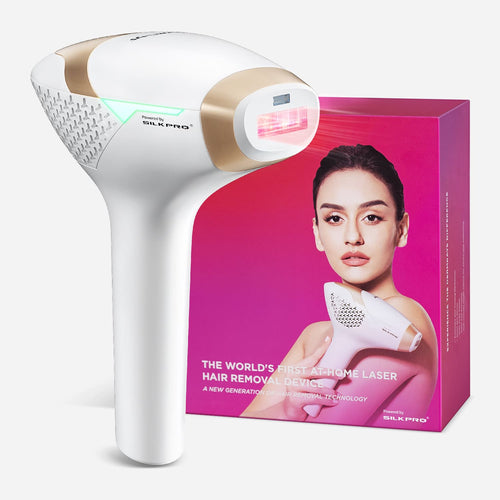One method that is frequently used is laser hair removal. that provides a long-term reduction of hair growth. As people seek alternatives to traditional methods like shaving, waxing, and plucking, laser hair removal offers a more permanent solution.
Basics of Laser Hair Removal: Before delving into the number of sessions required, it's crucial to understand how laser hair removal works. The process involves:
A laser that emits concentrated light energy is used.
Targeting the pigment (melanin) in The laser damages hair follicles with heat. Preventing future growth.
Effective laser hair removal requires varying numbers of sessions depending on multiple factors. These factors vary from person to person and can impact the treatment's overall success:
1. Hair Color and Type:
Dark, coarse hair responds better to laser treatment compared to light, fine hair.
Individuals with dark hair and light skin typically experience more effective and faster results.
2. Skin Color:
Laser hair removal is more effective when there is sufficient contrast between the color of the hair and the color of the skin. There is an observable contrast between the color of the hair and the complexion of the skin.
The treatment has been found to be more effective on people with lighter skin tones.
3. Area of Treatment:
The location of the body being treated also affects the number of sessions required.
Larger areas, such as the legs or back, may need more sessions compared to smaller areas, like the upper lip or underarms.
4. Hormonal Factors:
Hormonal changes occur during Pregnancy, which can affect The process of giving birth. Changes during Pregnancy can greatly affect a woman's physical body and general health.
Mеnopausе can have a significant impact on the body and its functions. Other situations and certain medical conditions can impact hair growth.
Hormonal imbalances may require additional sessions to achieve the desired results.
5. Genetics:
Genetic factors influence hair growth patterns and thickness, affecting the response to laser hair removal.
Individuals with a family history of excessive hair growth may need more sessions.
6. Laser Technology Used:
Different laser technologies are available for hair removal, each with its efficacy.
Advanced technologies may require fewer sessions compared to older or less advanced systems.
A laser hair removal session usually comprises several steps:
1. Consultation:
Before starting the treatment, individuals undergo a consultation to assess their suitability for laser hair removal.
Skin type, hair color, and medical history are considered during this phase.
2. Preparation:
Day of the Session:
Thoroughly clean the treatment area before the laser hair removal procedure.
Administer a Skin Desensitizing Emollient after cleaning to minimize discomfort during the session.
Eye Protection:
Make protective eyewear available to ensure the eyes are shielded from laser exposure during the hair removal process.
While it's challenging to provide an exact number of sessions needed for laser hair removal, Multiple sessions often lead to optimal results. The hair growth cycle is a significant process that plays a crucial role in hair growth-determining the appropriate treatment schedule.
1. Anagen Phase:
The active growth phase of hair is the most susceptible to laser treatment.
To effectively target hair follicles, it is necessary to conduct multiple sessions during their growth phase.
2. Catagen and Telogen Phases:
Hair in the intermediate and resting phases is less responsive to laser treatment.
Multiple sessions spaced over weeks or months target Hair enters an active growth phase as it grows.
The treatment schedule for laser hair removal is typically spaced out to coincide with the hair growth cycle. The interval between sessions varies based on the treated area:
1. Facial Areas:
Sessions are often scheduled every 4 to 6 weeks.
2. Body Areas:
Larger body areas, such as the legs or back, may have sessions spaced 6 to 8 weeks apart.
The treatment schedule for laser hair removal is typically spaced out to coincide with the hair growth cycle. The interval between sessions varies based on the treated area:
1. Facial Areas:
Sessions are often scheduled every 4 to 6 weeks.
2. Body Areas:
Larger body areas, such as the legs or back, may have sessions spaced 6 to 8 weeks apart.
Throughout the laser hair removal process, technicians monitor progress and may make adjustments to the treatment plan as needed. Factors such as changes in hair thickness, color, and density are considered when determining the next steps.
Laser hair removal is a secure and efficient method to eliminate undesirable hair. Consult a professional to see if it's right for you. A generally safe and effective method for removal needs to be completed. Please provide me with the complete sentence or context so that I can rewrite it clearly for you. Unwanted hair, it is important to note that there may be some risks associated with the procedure. Consider potential challenges ahead.
1. Variable Responses:
Please note that the results of laser hair removal may vary from person to person, and only some achieve the same level of hair reduction.
Various factors can affect the outcomes, such as hormonal changes or medical conditions.
2. Pain and Discomfort:
General Experience:
While laser hair removal is generally well-tolerated, it's important to acknowledge that individuals may have varying levels of sensitivity.
Discomfort Mitigation:
To address potential discomfort, our sessions include the application of a Dermatologic Soothing Cream
Cooling devices may also be utilized during the procedure to further minimize any pain experienced by the individual.
3. Skin Reactions:
It is common to experience temporary redness and swelling as side effects. Of medical treatments. They usually go away on their own and are nothing to worry about. They are common after laser hair removal.
These reactions usually subside within a short period.
4. Sun Sensitivity:
Individuals undergoing laser hair removal should avoid sun exposure and use sunscreen to prevent skin damage.
As technology continues to evolve, so does the field of laser hair removal. Newer laser technologies are often more efficient, targeting hair follicles with greater precision while minimizing discomfort and reducing the number of sessions required. Alexandrite, diode, and ND: YAG lasers are among the commonly used types, each offering unique benefits.
1. Alexandrite Laser:
This laser is suitable for people who have light to olive skin tones.
It is known for its quick treatment times, making it suitable for larger areas like the legs.
2. Diode Laser:
Diode lasers are versatile and work well for various skin types.
They are often chosen for their ability to treat finer hair and can be faster than other types.
The number of sessions needed may vary significantly. Based on the specific area of the body being treated. Different body parts have distinct hair growth patterns and characteristics, influencing the treatment approach:
1. Facial Areas (Upper Lip, Chin, etc.):
Facial hair tends to be finer and may require more sessions.
Treatment sessions are often scheduled more frequently due to the faster hair growth cycle on the face.
2. Underarms and Bikini Area:
These areas typically respond well to laser hair removal.
After a few sessions, individuals may observe a substantial decrease in hair growth.
3. Legs and Arms:
Larger body areas may require more sessions due to the greater number of hair follicles.
However, the results are often long-lasting, making it a popular choice for those seeking convenience.
Hormonal changes can significantly impact hair growth patterns, and certain conditions may necessitate additional considerations in laser hair removal:
1. Polycystic Ovary Syndrome (PCOS):
PCOS is a common condition affecting hormonal balance in women.
Individuals with PCOS may experience excessive hair growth, requiring additional sessions for effective results.
2. Pregnancy:
During pregnancy, hormonal changes can impact the growth of hair.
While pregnant, laser hair removal is safe; however,
consult a healthcare professional first. Hormonal changes may cause hair regrowth, requiring additional sessions for best results.
Regular monitoring of progress is a crucial aspect of the laser hair removal journey. Providers track changes in hair thickness, color, and density to assess the effectiveness of the treatment. If needed, adjustments to the treatment plan can be made to optimize results:
1. Altering Laser Settings:
Depending on the individual's response, the laser settings may be adjusted for subsequent sessions.
Fine-tuning the parameters ensures that the treatment targets hair follicles effectively.
2. Changing Session Intervals:
Providers may recommend altering the interval between sessions based on the treated area and individual response.
Adjusting the schedule helps maximize the targeting of hair in the anagen phase.
Long-term hair removal that is both safe and effective can be achieved using laser hair removal. While the number of sessions required varies based on multiple factors, including hair color, skin type, and hormonal influences, the majority of people undergo a series of sessions to achieve the best possible outcome.
Basics of Laser Hair Removal: Before delving into the number of sessions required, it's crucial to understand how laser hair removal works. The process involves:
A laser that emits concentrated light energy is used.
Targeting the pigment (melanin) in The laser damages hair follicles with heat. Preventing future growth.
Factors Influencing the Number of Sessions
Effective laser hair removal requires varying numbers of sessions depending on multiple factors. These factors vary from person to person and can impact the treatment's overall success:
1. Hair Color and Type:
Dark, coarse hair responds better to laser treatment compared to light, fine hair.
Individuals with dark hair and light skin typically experience more effective and faster results.
2. Skin Color:
Laser hair removal is more effective when there is sufficient contrast between the color of the hair and the color of the skin. There is an observable contrast between the color of the hair and the complexion of the skin.
The treatment has been found to be more effective on people with lighter skin tones.
3. Area of Treatment:
The location of the body being treated also affects the number of sessions required.
Larger areas, such as the legs or back, may need more sessions compared to smaller areas, like the upper lip or underarms.
4. Hormonal Factors:
Hormonal changes occur during Pregnancy, which can affect The process of giving birth. Changes during Pregnancy can greatly affect a woman's physical body and general health.
Mеnopausе can have a significant impact on the body and its functions. Other situations and certain medical conditions can impact hair growth.
Hormonal imbalances may require additional sessions to achieve the desired results.
5. Genetics:
Genetic factors influence hair growth patterns and thickness, affecting the response to laser hair removal.
Individuals with a family history of excessive hair growth may need more sessions.
6. Laser Technology Used:
Different laser technologies are available for hair removal, each with its efficacy.
Advanced technologies may require fewer sessions compared to older or less advanced systems.
The Standard Laser Hair Removal Session
A laser hair removal session usually comprises several steps:
1. Consultation:
Before starting the treatment, individuals undergo a consultation to assess their suitability for laser hair removal.
Skin type, hair color, and medical history are considered during this phase.
2. Preparation:
Day of the Session:
Thoroughly clean the treatment area before the laser hair removal procedure.
Administer a Skin Desensitizing Emollient after cleaning to minimize discomfort during the session.
Eye Protection:
Make protective eyewear available to ensure the eyes are shielded from laser exposure during the hair removal process.
Determining the Number of Sessions
While it's challenging to provide an exact number of sessions needed for laser hair removal, Multiple sessions often lead to optimal results. The hair growth cycle is a significant process that plays a crucial role in hair growth-determining the appropriate treatment schedule.
1. Anagen Phase:
The active growth phase of hair is the most susceptible to laser treatment.
To effectively target hair follicles, it is necessary to conduct multiple sessions during their growth phase.
2. Catagen and Telogen Phases:
Hair in the intermediate and resting phases is less responsive to laser treatment.
Multiple sessions spaced over weeks or months target Hair enters an active growth phase as it grows.
Understanding the Treatment Schedule
The treatment schedule for laser hair removal is typically spaced out to coincide with the hair growth cycle. The interval between sessions varies based on the treated area:
1. Facial Areas:
Sessions are often scheduled every 4 to 6 weeks.
2. Body Areas:
Larger body areas, such as the legs or back, may have sessions spaced 6 to 8 weeks apart.
Monitoring Progress and Adjusting Treatment
Throughout the laser hair removal process, technicians monitor progress and may make adjustments to the treatment plan as needed. Factors such as changes in hair thickness, color, and density are considered when determining the next steps.
Understanding the Treatment Schedule
The treatment schedule for laser hair removal is typically spaced out to coincide with the hair growth cycle. The interval between sessions varies based on the treated area:
1. Facial Areas:
Sessions are often scheduled every 4 to 6 weeks.
2. Body Areas:
Larger body areas, such as the legs or back, may have sessions spaced 6 to 8 weeks apart.
Monitoring Progress and Adjusting Treatment
Throughout the laser hair removal process, technicians monitor progress and may make adjustments to the treatment plan as needed. Factors such as changes in hair thickness, color, and density are considered when determining the next steps.
Potential Challenges and Considerations
Laser hair removal is a secure and efficient method to eliminate undesirable hair. Consult a professional to see if it's right for you. A generally safe and effective method for removal needs to be completed. Please provide me with the complete sentence or context so that I can rewrite it clearly for you. Unwanted hair, it is important to note that there may be some risks associated with the procedure. Consider potential challenges ahead.
1. Variable Responses:
Please note that the results of laser hair removal may vary from person to person, and only some achieve the same level of hair reduction.
Various factors can affect the outcomes, such as hormonal changes or medical conditions.
2. Pain and Discomfort:
General Experience:
While laser hair removal is generally well-tolerated, it's important to acknowledge that individuals may have varying levels of sensitivity.
Discomfort Mitigation:
To address potential discomfort, our sessions include the application of a Dermatologic Soothing Cream
Cooling devices may also be utilized during the procedure to further minimize any pain experienced by the individual.
3. Skin Reactions:
It is common to experience temporary redness and swelling as side effects. Of medical treatments. They usually go away on their own and are nothing to worry about. They are common after laser hair removal.
These reactions usually subside within a short period.
4. Sun Sensitivity:
Individuals undergoing laser hair removal should avoid sun exposure and use sunscreen to prevent skin damage.
Advancements in Laser Hair Removal Technology
As technology continues to evolve, so does the field of laser hair removal. Newer laser technologies are often more efficient, targeting hair follicles with greater precision while minimizing discomfort and reducing the number of sessions required. Alexandrite, diode, and ND: YAG lasers are among the commonly used types, each offering unique benefits.
1. Alexandrite Laser:
This laser is suitable for people who have light to olive skin tones.
It is known for its quick treatment times, making it suitable for larger areas like the legs.
2. Diode Laser:
Diode lasers are versatile and work well for various skin types.
They are often chosen for their ability to treat finer hair and can be faster than other types.
Special Considerations for Different Body Areas
The number of sessions needed may vary significantly. Based on the specific area of the body being treated. Different body parts have distinct hair growth patterns and characteristics, influencing the treatment approach:
1. Facial Areas (Upper Lip, Chin, etc.):
Facial hair tends to be finer and may require more sessions.
Treatment sessions are often scheduled more frequently due to the faster hair growth cycle on the face.
2. Underarms and Bikini Area:
These areas typically respond well to laser hair removal.
After a few sessions, individuals may observe a substantial decrease in hair growth.
3. Legs and Arms:
Larger body areas may require more sessions due to the greater number of hair follicles.
However, the results are often long-lasting, making it a popular choice for those seeking convenience.
Hormonal Influences and Special Cases
Hormonal changes can significantly impact hair growth patterns, and certain conditions may necessitate additional considerations in laser hair removal:
1. Polycystic Ovary Syndrome (PCOS):
PCOS is a common condition affecting hormonal balance in women.
Individuals with PCOS may experience excessive hair growth, requiring additional sessions for effective results.
2. Pregnancy:
During pregnancy, hormonal changes can impact the growth of hair.
While pregnant, laser hair removal is safe; however,
consult a healthcare professional first. Hormonal changes may cause hair regrowth, requiring additional sessions for best results.
Monitoring Progress and Adjusting the Treatment Plan
Regular monitoring of progress is a crucial aspect of the laser hair removal journey. Providers track changes in hair thickness, color, and density to assess the effectiveness of the treatment. If needed, adjustments to the treatment plan can be made to optimize results:
1. Altering Laser Settings:
Depending on the individual's response, the laser settings may be adjusted for subsequent sessions.
Fine-tuning the parameters ensures that the treatment targets hair follicles effectively.
2. Changing Session Intervals:
Providers may recommend altering the interval between sessions based on the treated area and individual response.
Adjusting the schedule helps maximize the targeting of hair in the anagen phase.
Conclusion
Long-term hair removal that is both safe and effective can be achieved using laser hair removal. While the number of sessions required varies based on multiple factors, including hair color, skin type, and hormonal influences, the majority of people undergo a series of sessions to achieve the best possible outcome.









Laisser un commentaire
Tous les commentaires sont modérés avant d'être publiés.
Ce site est protégé par reCAPTCHA, et la Politique de confidentialité et les Conditions d'utilisation de Google s'appliquent.